heater TOYOTA iQ EV 2013 Owners Manual (in English)
[x] Cancel search | Manufacturer: TOYOTA, Model Year: 2013, Model line: iQ EV, Model: TOYOTA iQ EV 2013Pages: 444, PDF Size: 7.34 MB
Page 3 of 444
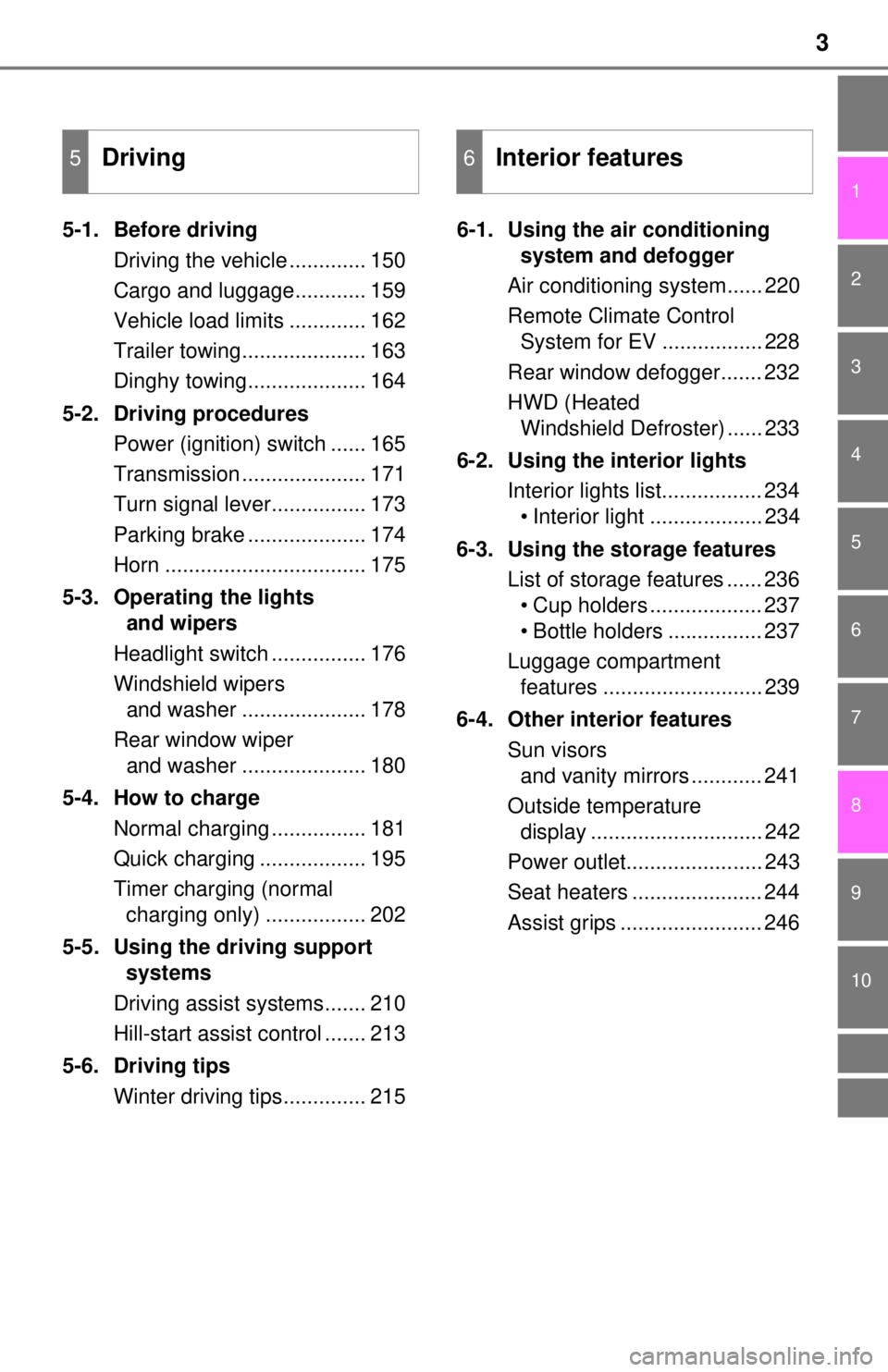
3
9 8
7
6
5
4
3
10
1
2
5-1. Before drivingDriving the vehicle ............. 150
Cargo and luggage............ 159
Vehicle load limits ............. 162
Trailer towing..................... 163
Dinghy towing.................... 164
5-2. Driving procedures Power (ignition) switch ...... 165
Transmission ..................... 171
Turn signal lever................ 173
Parking brake .................... 174
Horn .................................. 175
5-3. Operating the lights and wipers
Headlight switch ................ 176
Windshield wipers and washer ..................... 178
Rear window wiper and washer ..................... 180
5-4. How to charge Normal charging ................ 181
Quick charging .................. 195
Timer charging (normal charging only) ................. 202
5-5. Using the driving support systems
Driving assist systems....... 210
Hill-start assist control ....... 213
5-6. Driving tips Winter driving tips.............. 215 6-1. Using the air conditioning
system and defogger
Air conditioning system...... 220
Remote Climate Control System for EV ................. 228
Rear window defogger....... 232
HWD (Heated Windshield Defroster) ...... 233
6-2. Using the interior lights Interior lights list................. 234• Interior light ................... 234
6-3. Using the storage features List of storage features ...... 236• Cup holders ................... 237
• Bottle holders ................ 237
Luggage compartment features ........................... 239
6-4. Other interior features Sun visors and vanity mirrors ............ 241
Outside temperature display ............................. 242
Power outlet....................... 243
Seat heaters ...................... 244
Assist grips ........................ 246
5Driving6Interior features
Page 17 of 444
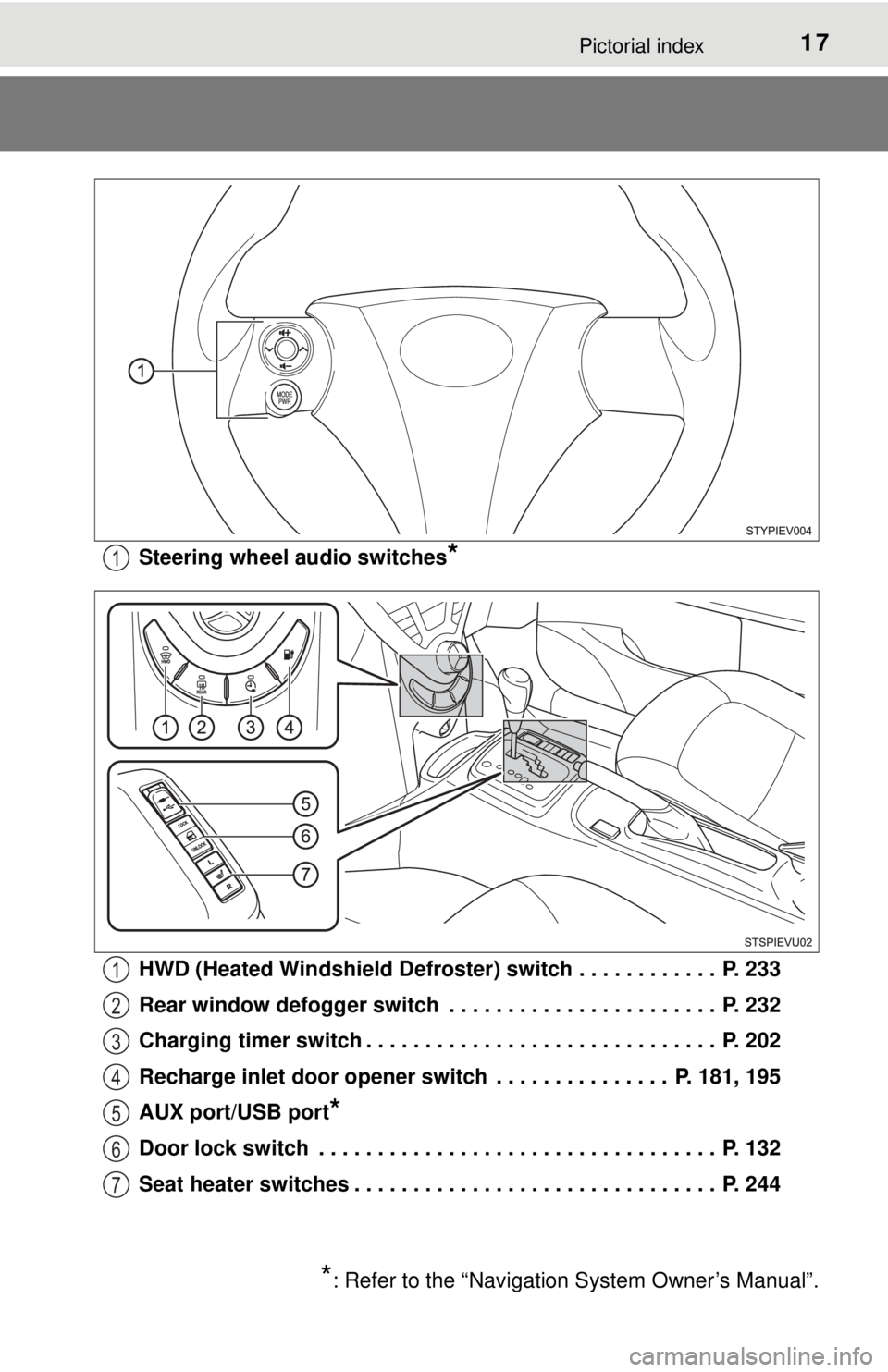
17Pictorial index
Steering wheel audio switches*
HWD (Heated Windshield Defroster) switch . . . . . . . . . . . . P. 233
Rear window defogger switch . . . . . . . . . . . . . . . . . . . . . . . P. 232
Charging timer switch . . . . . . . . . . . . . . . . . . . . . . . . . . . . . . P. 202
Recharge inlet door opener switch . . . . . . . . . . . . . . . P. 181, 195
AUX port/USB port
*
Door lock switch . . . . . . . . . . . . . . . . . . . . . . . . . . . . . . . . . . P. 132
Seat heater switches . . . . . . . . . . . . . . . . . . . . . . . . . . . . . . . P. 244
*: Refer to the “Navigation System Owner’s Manual”.
1
1
2
3
4
5
6
7
Page 90 of 444
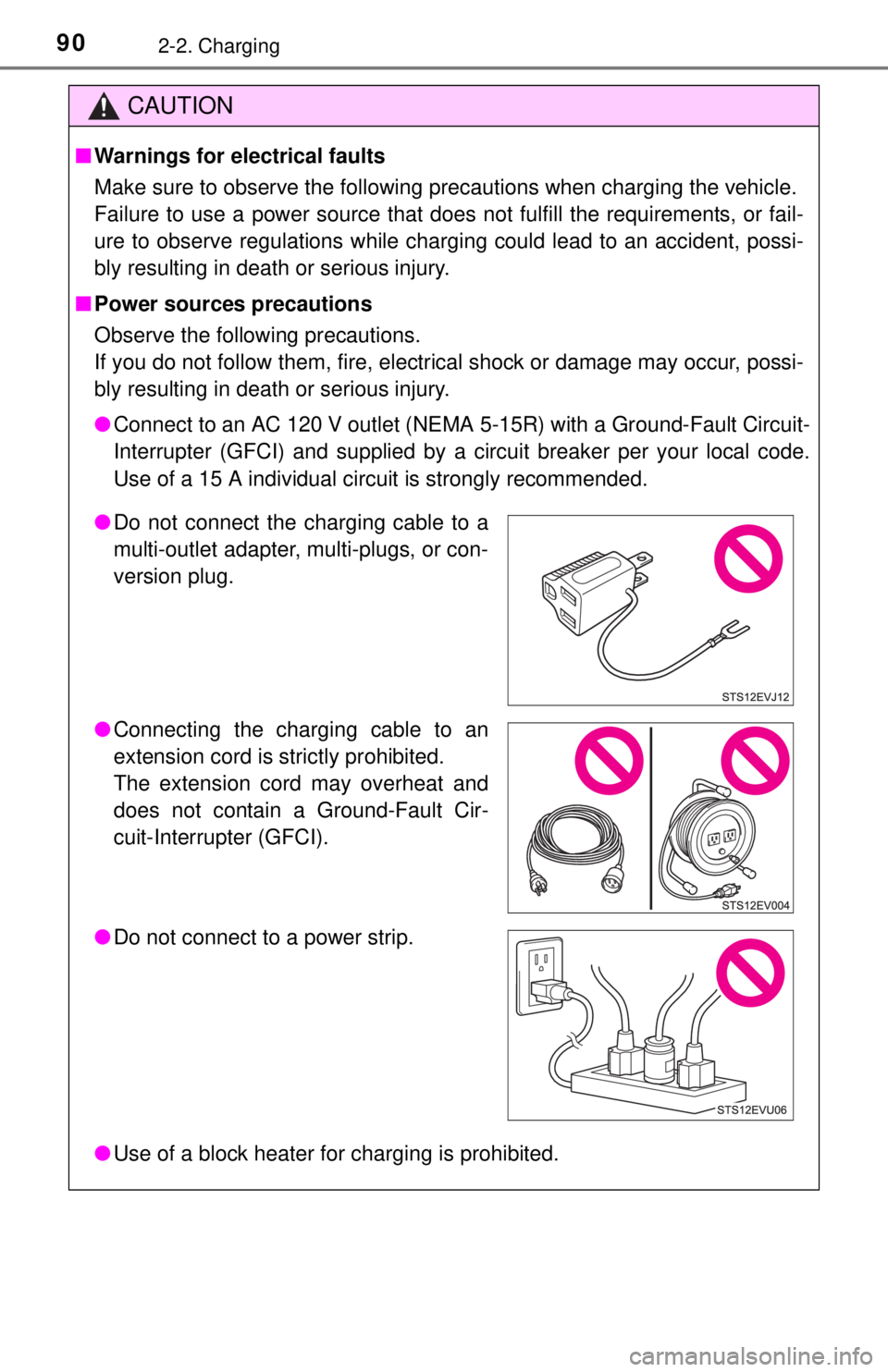
902-2. Charging
CAUTION
■Warnings for electrical faults
Make sure to observe the following precautions when charging the vehicle\
.
Failure to use a power source that does not fulfill the requirements, or fail-
ure to observe regulations while charging could lead to an accident, possi-
bly resulting in death or serious injury.
■ Power sources precautions
Observe the following precautions.
If you do not follow them, fire, electrical shock or damage may occur, possi-
bly resulting in death or serious injury.
● Connect to an AC 120 V outlet (NEMA 5-15R) with a Ground-Fault Circuit-
Interrupter (GFCI) and supplied by a circuit breaker per your local code.
Use of a 15 A individual circuit is strongly recommended.
● Use of a block heater for charging is prohibited.
●Do not connect the charging cable to a
multi-outlet adapter, multi-plugs, or con-
version plug.
● Connecting the charging cable to an
extension cord is strictly prohibited.
The extension cord may overheat and
does not contain a Ground-Fault Cir-
cuit-Interrupter (GFCI).
● Do not connect to a power strip.
Page 97 of 444

972-3. Driving the EV (Electric Vehicle)
2
EV system
■Air conditioning on/off
●Switch the air conditioning off when it is not needed. Doing so
can help control excessive elec tricity and power consumption.
In summer:
In high temperatures, use the re circulated air mode. Doing so will
help to reduce the burden on the air conditioning and reduce
power consumption as well.
In winter:
Excessive or unnecessary heating should be avoided. The use of
the seat heater ( P. 244) is effective to avoid excessive power
consumption.
● For efficiency, use the Remote Climate Control before departing
while the charging cable is connected. ( P. 228)
■Checking tire inflation pressure
Make sure to check the tire infl ation pressure frequently. Improper
tire inflation pressure can cause poor power consumption.
Also, as snow tires can cause large amounts of friction, their use on
dry roads will lead to p oor power consumption. Use tires that are
appropriate for the season.
■Luggage
Carrying heavy luggage can require excessive energy. Avoid leav-
ing unnecessary luggage in the vehicle.
Page 219 of 444

219
6Interior features
6-1. Using the air conditioning system and defogger
Air conditioning system ..... 220
Remote Climate Control System for EV ................. 228
Rear window defogger ...... 232
HWD (Heated Windshield Defroster) ..... 233
6-2. Using the interior lights Interior lights list ................ 234• Interior light ................... 234
6-3. Using the storage features List of storage features ..... 236• Cup holders .................. 237
• Bottle holders ................ 237
Luggage compartment features ........................... 239
6-4. Other interior features Sun visors and vanity mirrors ........... 241
Outside temperature display............................. 242
Power outlet ...................... 243
Seat heaters...................... 244
Assist grips........................ 246
Page 228 of 444
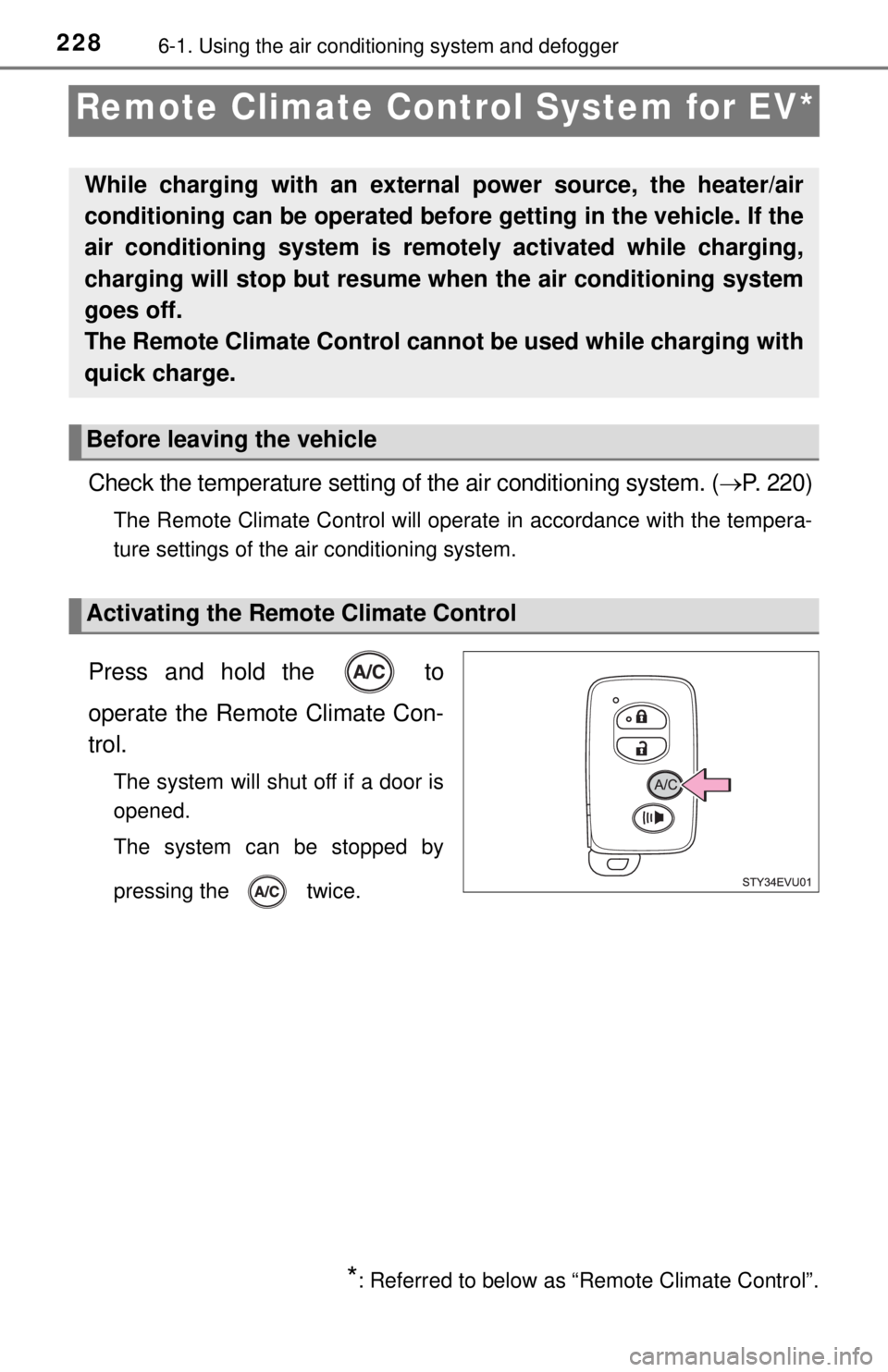
2286-1. Using the air conditioning system and defogger
Remote Climate Control System for EV*
Check the temperature setting of the air conditioning system. ( P. 220)
The Remote Climate Control will operate in accordance with the tempera-
ture settings of the air conditioning system.
Press and hold the to
operate the Remote Climate Con-
trol.
The system will shut off if a door is
opened.
The system can be stopped by
pressing the twice.
While charging with an external power source, the heater/air
conditioning can be operated before getting in the vehicle. If the
air conditioning system is remote ly activated while charging,
charging will stop but resume when the air conditioning system
goes off.
The Remote Climate Control cannot be used while charging with
quick charge.
Before leaving the vehicle
Activating the Remote Climate Control
*: Referred to below as “Remote Climate Control”.
Page 230 of 444
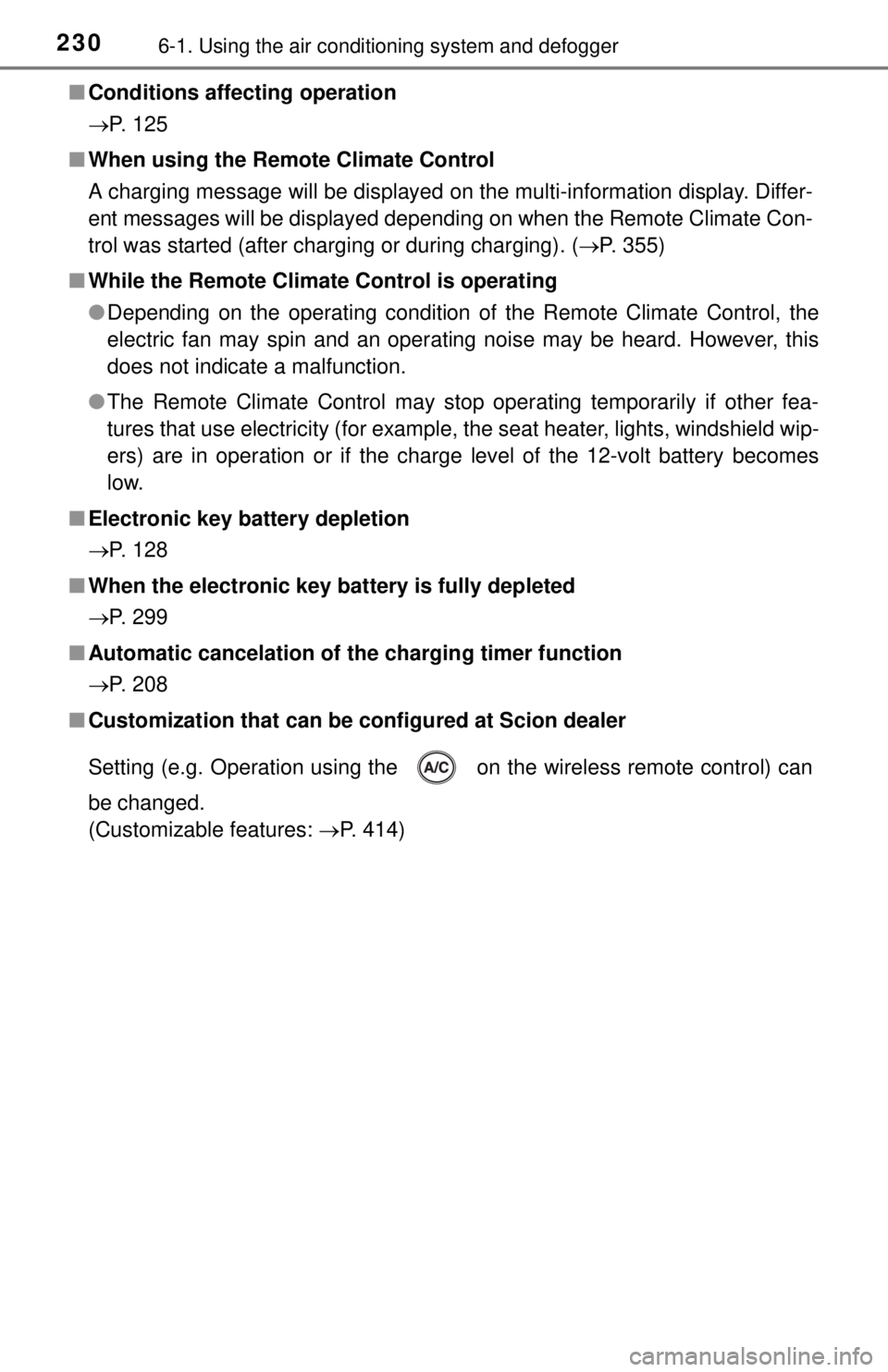
2306-1. Using the air conditioning system and defogger
■Conditions affecting operation
P. 125
■ When using the Remo te Climate Control
A charging message will be displayed on the multi-information display. Differ-
ent messages will be displayed depending on when the Remote Climate Con-
trol was started (after charging or during charging). ( P. 355)
■ While the Remote Climate Control is operating
●Depending on the operating condition of the Remote Climate Control, the
electric fan may spin and an operating noise may be heard. However, this
does not indicate a malfunction.
● The Remote Climate Control may stop operating temporarily if other fea-
tures that use electricity (for example, the seat heater, lights, windshield wip-
ers) are in operation or if the charge level of the 12-volt battery becomes
low.
■ Electronic key battery depletion
P. 128
■ When the electronic key battery is fully depleted
P. 299
■ Automatic cancelation of the charging timer function
P. 208
■ Customization that can be configured at Scion dealer
Setting (e.g. Operation using the on the wireless remote control) can
be changed.
(Customizable features: P. 414)
Page 244 of 444
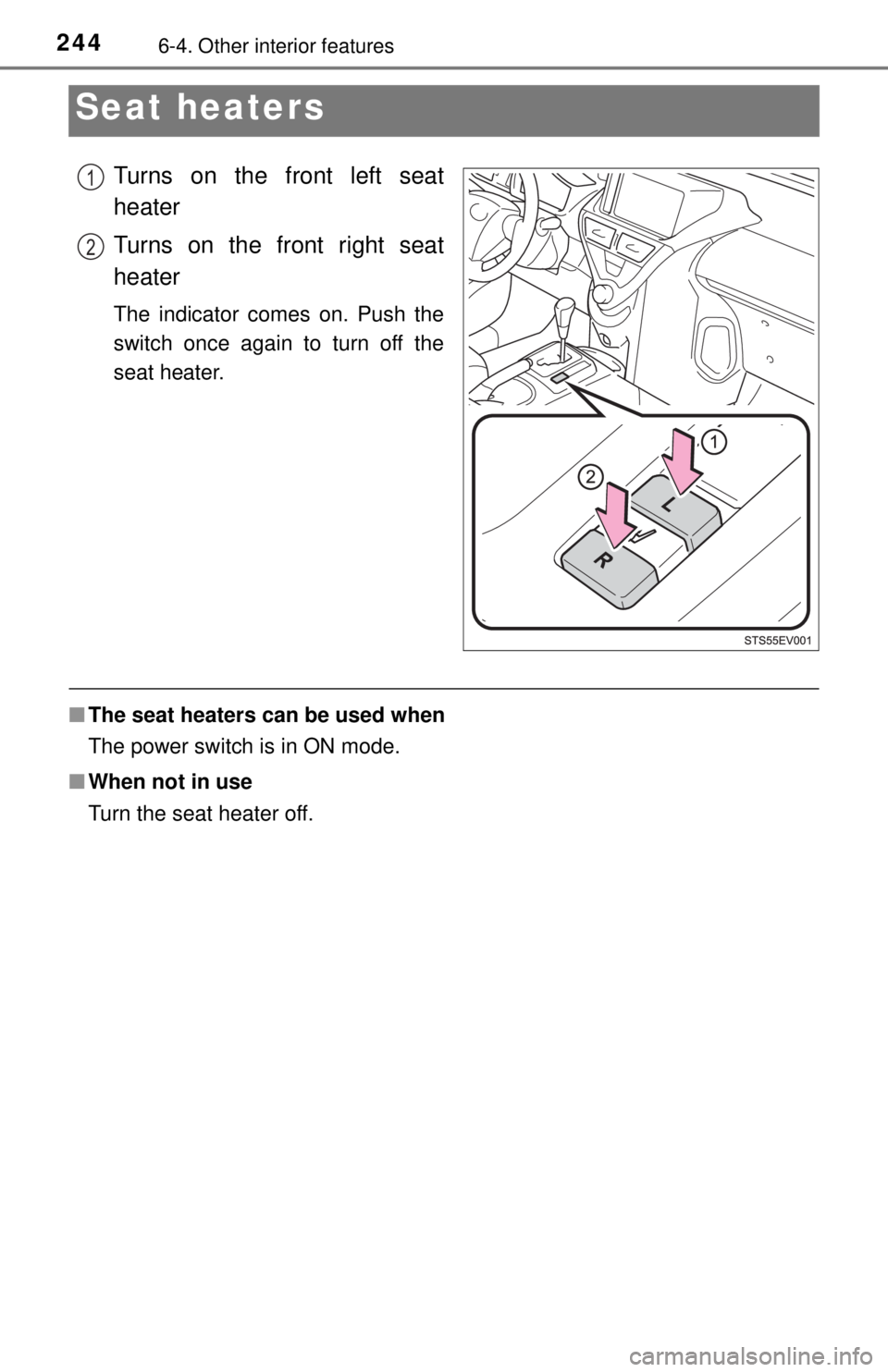
2446-4. Other interior features
Seat heaters
Turns on the front left seat
heater
Turns on the front right seat
heater
The indicator comes on. Push the
switch once again to turn off the
seat heater.
■The seat heaters can be used when
The power switch is in ON mode.
■ When not in use
Turn the seat heater off.
1
2
Page 245 of 444
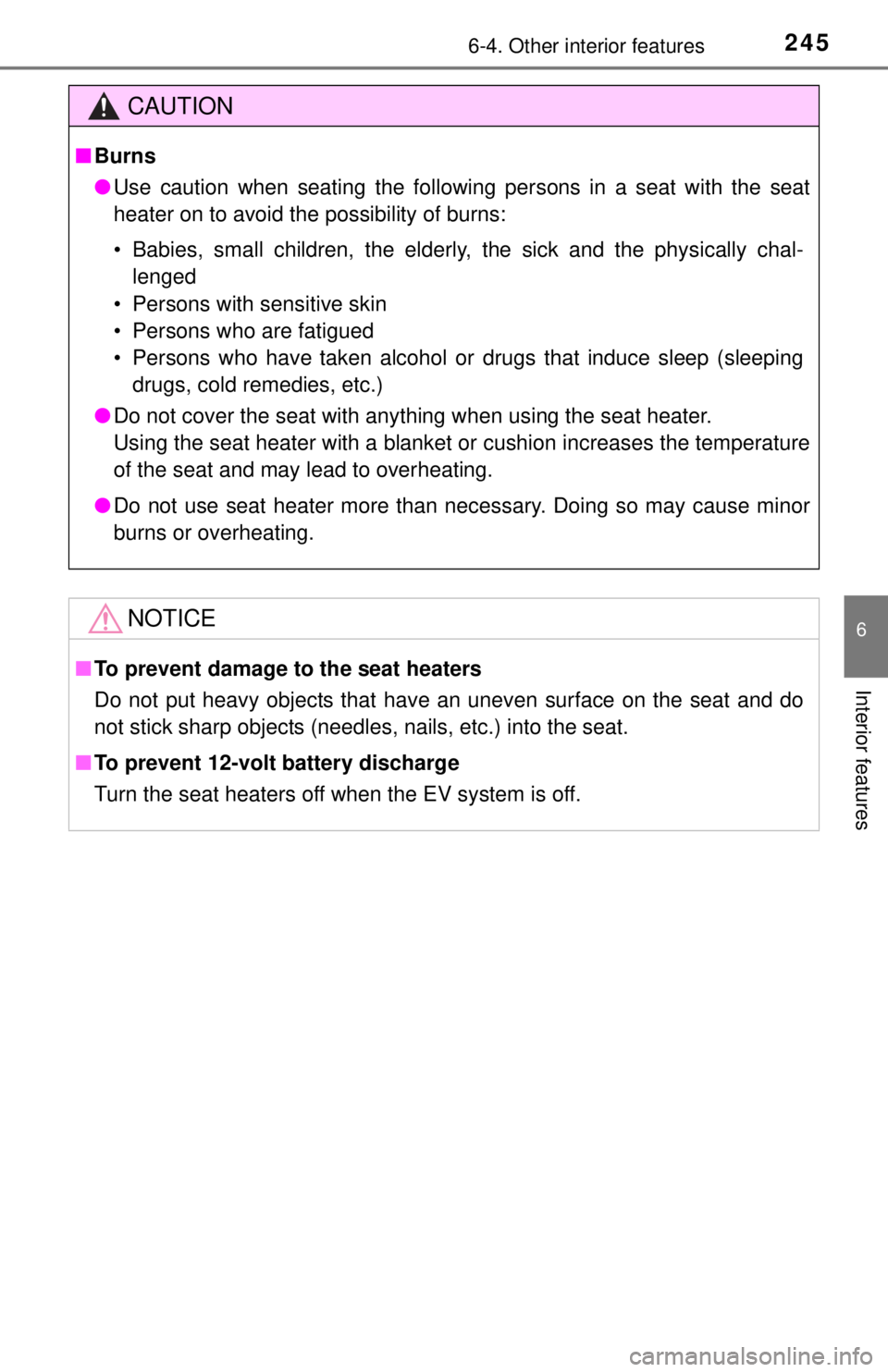
2456-4. Other interior features
6
Interior features
CAUTION
■Burns
● Use caution when seating the following persons in a seat with the seat
heater on to avoid the possibility of burns:
• Babies, small children, the elderly, the sick and the physically chal-
lenged
• Persons with sensitive skin
• Persons who are fatigued
• Persons who have taken alcohol or drugs that induce sleep (sleeping drugs, cold remedies, etc.)
● Do not cover the seat with anything when using the seat heater.
Using the seat heater with a blanket or cushion increases the temperature
of the seat and may lead to overheating.
● Do not use seat heater more than necessary. Doing so may cause minor
burns or overheating.
NOTICE
■To prevent damage to the seat heaters
Do not put heavy objects that have an uneven surface on the seat and do
not stick sharp objects (needles, nails, etc.) into the seat.
■ To prevent 12-volt battery discharge
Turn the seat heaters off when the EV system is off.
Page 253 of 444
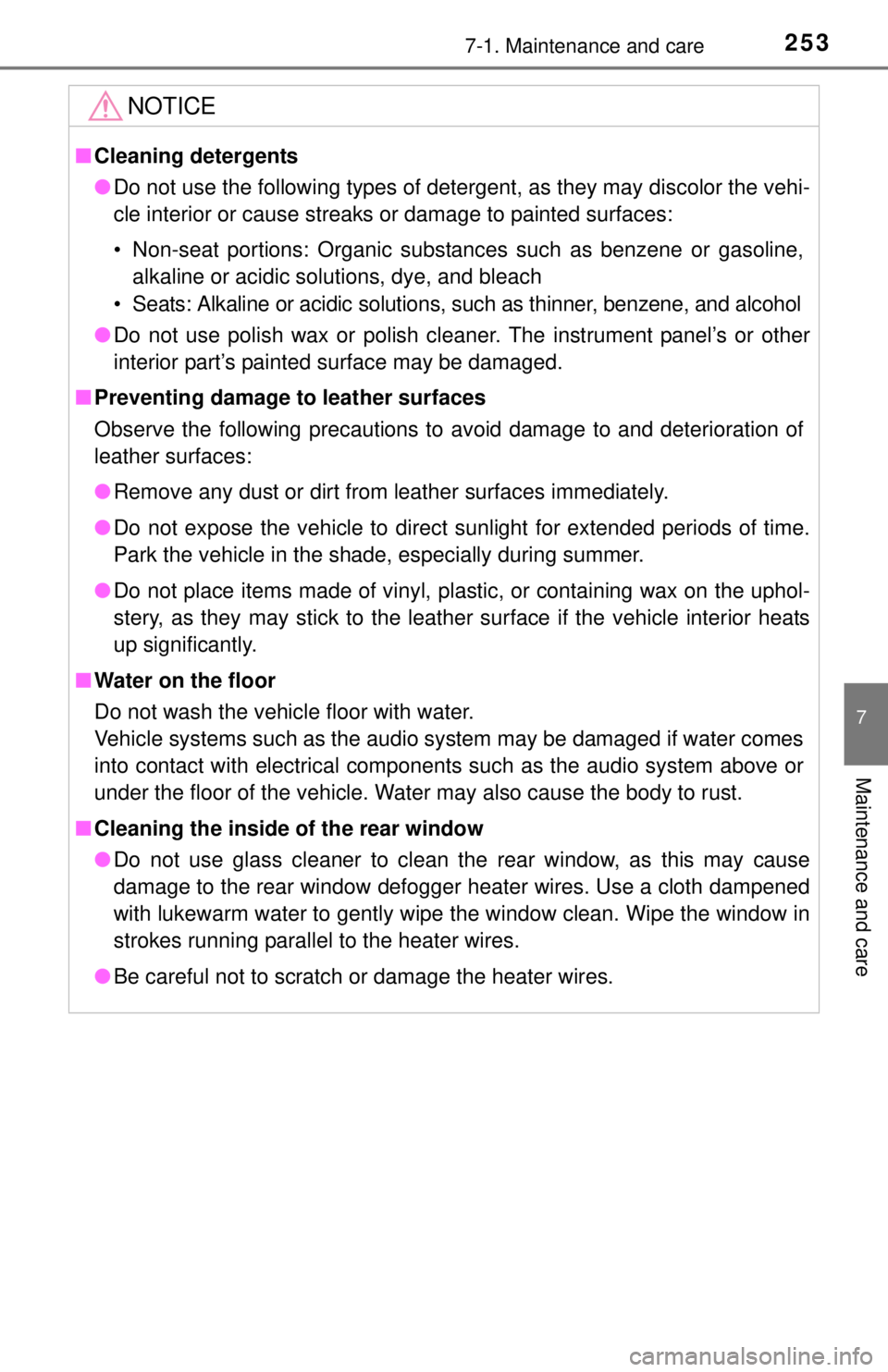
2537-1. Maintenance and care
7
Maintenance and care
NOTICE
■Cleaning detergents
● Do not use the following types of detergent, as they may discolor the vehi-
cle interior or cause streaks or damage to painted surfaces:
• Non-seat portions: Organic substances such as benzene or gasoline,
alkaline or acidic solutions, dye, and bleach
• Seats: Alkaline or acidic solutions, such as thinner, benzene, and alcohol
● Do not use polish wax or polish cleaner. The instrument panel’s or other
interior part’s painted surface may be damaged.
■ Preventing damage to leather surfaces
Observe the following precautions to avoid damage to and deterioration of
leather surfaces:
● Remove any dust or dirt from leather surfaces immediately.
● Do not expose the vehicle to direct sunlight for extended periods of time.
Park the vehicle in the shade, especially during summer.
● Do not place items made of vinyl, plastic, or containing wax on the uphol-
stery, as they may stick to the leather surface if the vehicle interior heats
up significantly.
■ Water on the floor
Do not wash the vehicle floor with water.
Vehicle systems such as the audio system may be damaged if water comes
into contact with electrical components such as the audio system above or
under the floor of the vehicle. Water may also cause the body to rust.
■ Cleaning the inside of the rear window
● Do not use glass cleaner to clean the rear window, as this may cause
damage to the rear window defogger heater wires. Use a cloth dampened
with lukewarm water to gently wipe the window clean. Wipe the window in
strokes running parallel to the heater wires.
● Be careful not to scratch or damage the heater wires.